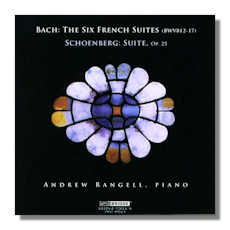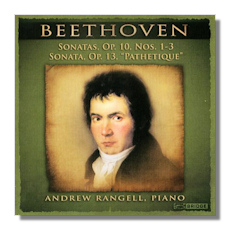
The Internet's Premier Classical Music Source
Related Links
-
J.S. Bach Reviews
Beethoven Reviews
Ives Reviews
Nielsen Reviews
Schoenberg Reviews - Latest Reviews
- More Reviews
-
By Composer
-
Collections
DVD & Blu-ray
Books
Concert Reviews
Articles/Interviews
Software
Audio
Search Amazon
Recommended Links
Site News
 CD Review
CD Review
Andrew Rangell Plays

- Johann Sebastian Bach: The French Suites, BWV 812-817
- Arnold Schoenberg: Suite, Op. 25
Andrew Rangell, piano
Bridge 9281A/B DDD 2CDs 59:08, 47:40


Ludwig van Beethoven
- Sonata for Piano #5 in C minor, Op. 10 #1
- Sonata for Piano #6 in F Major, Op. 10 #2
- Sonata for Piano #7 in D Major, Op. 10 #3
- Sonata for Piano #8 "Pathétique" in C minor, Op. 13
Andrew Rangell, piano
Bridge 9297 DDD 78:14


- Carl Nielsen: Luciferian Suite, Op. 45
- John McDonald: Meditation Before a Sonata: Dew Cloth, Dream Drapery, Op. 406
- Charles Ives: First Sonata
Andrew Rangell, piano
Bridge 9295 DDD 68:56
There are the flashy pianists, who win international competitions and play a lot of Rachmaninov, and then there are the modest ones – often quirky but sometimes not – who appeal to our intellects. If Lang Lang is like a summer blockbuster from Hollywood, Andrew Rangell is like an American "indie" film, or an import from Europe in which "nothing happens" for two hours except talking, and yet the audience goes home either uplifted or wrung out
Now in his sixties, Chicago-born Rangell studied at Juilliard and has had a long career as a pianist and pedagogue – mostly in and around New England. His attitude toward music, and toward the way it is performed, has earned him frequent comparisons to late Canadian pianist Glenn Gould. Early in the 90s, Rangell was sidelined by a hand injury, but returned to concert life at the end of the decade, although he continues to struggle with neuromuscular problems. These have limited his ability to give concerts, although he continues to record, finding it, according to an article in The Boston Globe, "the most powerful, concentrated, and permanent means of expression."
Bridge Records has released several of Rangell's CDs – three within in the last year. They make for absorbing listening. All three were recorded in Boston's Gardner Museum – appropriate, since the museum's opening in 1903 was celebrated with the music of Bach, Mozart, and Schumann – and include Rangell's own intelligent and inviting booklet notes.
His are among the most personal interpretation of Bach's French Suites – right up there with João Carlos Martins'. (But then again, they are very much unlike Martins'.) Listeners will at once notice Rangell's anything but metronomic tempos and the extreme suppleness of his phrasing. Rangell is like a snake-charmer coaxing the Bachian cobra out of its basket, and then taming it. His pedaling is rich, and his style, while not hyper-emotional, owes much to Romanticism. This is intimate Bach – inviting and as appropriate for late-night reveries as for intellectual contemplation in the bright light of day. He takes the repeats and embellishes tastefully. In three cases he reprises one of the interior movements to create an ABA pattern. Rather than performing the suites in numerical order, Rangell plays them in the following order: #1, #5, #2, #4, #3, and #6. Presumably he does this to avoid following three minor-key suites with three major-key suites. Although it initially caught me off guard, I found it inoffensive, and it does make sense.
The Schoenberg Suite (from 1925) follows Bach's French Suite #6 so abruptly I really had to laugh – out of delight, not derision! – and there's much about Rangell's playing in this work that evoked the same response, and for the same reason. With its six movements, including a Gavotte, Musette, Menuet, and Gigue, Schoenberg's Suite clearly is modeled after Baroque suites as composed by Bach and his contemporaries. Of course, as Rangell points out in his booklet notes, "lurking throughout are subversions and derelictions of the Baroque model." Compared to Paul Jacobs on his popular Nonesuch recording of this music, Rangell is a little slow (except in the Menuet and Trio), but Rangell gives us more time to process the music, and to more fully appreciate how "idiosyncratic" and even "naughty" it can be.
Rangell has recorded an earlier Beethoven sonata disc for Bridge (Bridge 9181) and two for Dorian (DOR-90143 and DOR-90158), so one hopes that Rangell will get around to all of the sonatas in good time. (However, with Bridge also reissuing Garrick Ohlsson's series of the Beethoven sonatas, who can tell?) Rangell has a lot to say in this repertory as well, although I think he is less idiosyncratic in Beethoven than he is in Bach. Then again, Beethoven's musical temperament was more idiosyncratic than Bach's, so one could argue that Rangell is simply balancing out the two composers. Even so, listen to the portentous introduction to Rangell's "Pathétique" and tell me if this is pianistic business as usual! This sonata, perhaps because it is the most familiar of the four, seems to bring out Rangell's most unusual thoughts.
When Beethoven treads a fine line between humor and peevishness – for example, in the first movement of the Sonata #6 – Rangell is right there with him, although the refinement of his playing helps him to avoid seeming merely brusque. In the second movement of the same sonata, one is impressed with Rangell's clarity and fine articulation and with his sensitivity to the music's currents and eddies. As on the Bach discs, there is ample flexibility, and a surprise waiting around every corner, although here we sense that the surprises are Beethoven's as much as they are Rangell's.
The most creative and varied program of all is the last (and the most recent to be recorded). Rangell's written introduction to this CD begins with a discussion of the several parallels between Nielsen and Ives – both idiosyncratic composers for whom Rangell has long felt "special affection and admiration." Nielsen's Luciferian Suite (perhaps better known by its Danish title – Den Luciferiske) was not intended to be about matters demonic, in the usual sense of the word. "Lucifer" also means "bearer of light" – in other words, the morning star, although I am not sure how that relates to the music either! At any rate, the Luciferian Suite is an unjustly neglected composition from an unjustly neglected body of work. (Nielsen's symphonies are great, but let's give the rest of his music a chance!) Its six movements reveal the composer's penetrating intelligence and subtlety – no wonder he sometimes is compared with Busoni – and Rangell's clear-headed playing brings out the music's best.
Ives's First Sonata is played less often than its successor, the "Concord" Sonata. An epic novel in which slapstick and metaphysics collide, it can be a tough nut to crack in recital, and perhaps is best enjoyed at home with one's feet up on the ottoman. Rangell has a rollicking good time with the ragtime-inflected second and fourth movements, and does a great job of making sense – and something weirdly attractive – out of this neglected sonata.
Ives prefaced his "Concord" Sonata with the prose "Essays Before a Sonata." In 2003, Rangell asked his friend, composer John McDonald, to write a short musical piece that could be performed immediately before the "Concord." The work recorded here was the result, although on this CD it is played in front of the other Ives piano sonata. This is a lovely, mysterious bit of musical impressionism, evocative (according to Rangell, anyway) of Walden Pond, and subtly quoting Ives, or materials Ives quoted elsewhere. This is quite an impressive work, and it works well in this setting. I hope to hear more from McDonald, "a composer who tries to play the piano and a pianist who tries to compose."
Rangell and Bridge Records go well together, and I look forward to enjoying more of their offspring!
Copyright © 2009, Raymond Tuttle




















